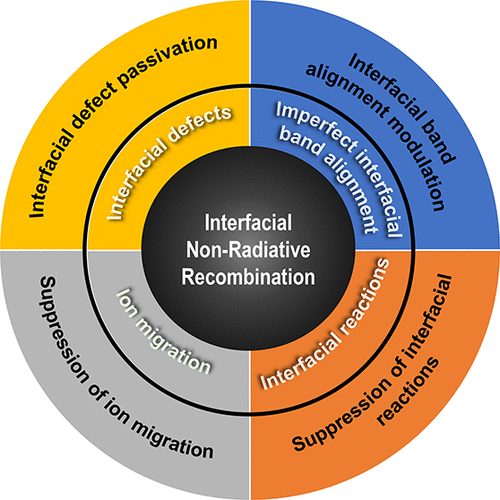当前位置:
X-MOL 学术
›
ACS Energy Lett.
›
论文详情
Our official English website, www.x-mol.net, welcomes your
feedback! (Note: you will need to create a separate account there.)
Materials and Methods for Interface Engineering toward Stable and Efficient Perovskite Solar Cells
ACS Energy Letters ( IF 19.3 ) Pub Date : 2020-07-27 , DOI: 10.1021/acsenergylett.0c01240 Jiangzhao Chen 1 , Nam-Gyu Park 2
ACS Energy Letters ( IF 19.3 ) Pub Date : 2020-07-27 , DOI: 10.1021/acsenergylett.0c01240 Jiangzhao Chen 1 , Nam-Gyu Park 2
Affiliation

|
Because interfacial nonradiative recombination (NRR) has a significant influence on device performance, the minimization of interfacial NRR losses through interface engineering especially for perovskite-related interfaces is key to achieving efficient, stable, and hysteresis-free perovskite solar cells (PSCs). In light of important contributions of interface engineering to rapid development of PSCs, a systematic investigation and analysis on the latest research advancements on interface engineering is urgently needed. This Review aims at providing innovative insights into further improvement in power conversion efficiency (PCE) toward the Shockley–Queisser limit efficiency and stability fulfilling commercially available standard protocols as well as reduction of hysteresis. In this Review, the roles and importance of interfaces in PSCs are first highlighted from the viewpoint of device structure, working principles, and interfacial carrier dynamics. The main origins (i.e., interface defects, imperfect energy level alignment (ELA), and interfacial reactions) of interfacial NRR are then discussed in detail along with characterization techniques. Subsequently, the effects of interfacial NRR on PCE, stability, and hysteresis are investigated. Strategies for mitigating interfacial NRR are provided in terms of defect passivation, ELA modulation, and suppression of interfacial reaction, where the critical roles of functional groups of interface modifiers are emphasized. Finally, we provide an outlook for efficient, hysteresis-free, and long-term operationally stable PSCs achievable via interface engineering.
中文翻译:

稳定高效的钙钛矿太阳能电池接口工程的材料和方法
由于界面非辐射复合(NRR)对器件性能具有重大影响,因此通过界面工程(尤其是钙钛矿相关界面)的界面NRR损失最小化是实现高效,稳定且无滞后的钙钛矿太阳能电池(PSC)的关键。鉴于接口工程对PSC快速发展的重要贡献,迫切需要对接口工程的最新研究进展进行系统的调查和分析。这篇综述旨在提供创新的见解,以进一步改善电源转换效率(PCE),以实现Shockley–Queisser极限效率和稳定性,从而满足商业上可用的标准协议,并减少磁滞现象。在这篇评论中,首先从设备结构,工作原理和界面载流子动力学的角度强调了接口在PSC中的作用和重要性。界面NRR的主要来源(即界面缺陷,不完善的能级排列(ELA)和界面反应)随后将与表征技术一起进行详细讨论。随后,研究了界面NRR对PCE,稳定性和磁滞的影响。从缺陷钝化,ELA调制和抑制界面反应方面提供了减轻界面NRR的策略,其中强调了界面修饰剂官能团的关键作用。最后,我们提供了通过接口工程可实现的高效,无滞后和长期运行稳定的PSC的前景。
更新日期:2020-08-14
中文翻译:

稳定高效的钙钛矿太阳能电池接口工程的材料和方法
由于界面非辐射复合(NRR)对器件性能具有重大影响,因此通过界面工程(尤其是钙钛矿相关界面)的界面NRR损失最小化是实现高效,稳定且无滞后的钙钛矿太阳能电池(PSC)的关键。鉴于接口工程对PSC快速发展的重要贡献,迫切需要对接口工程的最新研究进展进行系统的调查和分析。这篇综述旨在提供创新的见解,以进一步改善电源转换效率(PCE),以实现Shockley–Queisser极限效率和稳定性,从而满足商业上可用的标准协议,并减少磁滞现象。在这篇评论中,首先从设备结构,工作原理和界面载流子动力学的角度强调了接口在PSC中的作用和重要性。界面NRR的主要来源(即界面缺陷,不完善的能级排列(ELA)和界面反应)随后将与表征技术一起进行详细讨论。随后,研究了界面NRR对PCE,稳定性和磁滞的影响。从缺陷钝化,ELA调制和抑制界面反应方面提供了减轻界面NRR的策略,其中强调了界面修饰剂官能团的关键作用。最后,我们提供了通过接口工程可实现的高效,无滞后和长期运行稳定的PSC的前景。











































 京公网安备 11010802027423号
京公网安备 11010802027423号